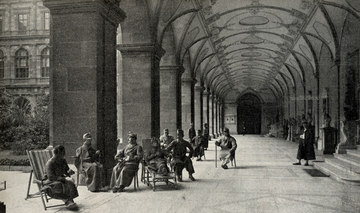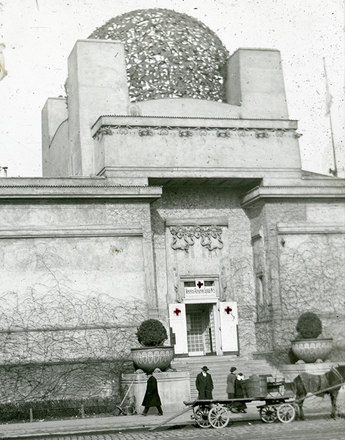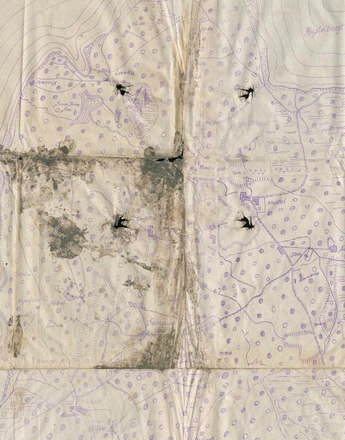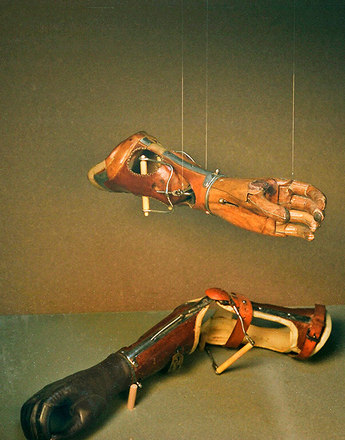The University of Vienna, University of Technology and other institutions were converted to become temporary hospitals. Because of the reduction in the number of students, the teaching was not disrupted.
Among the prominent buildings converted into temporary hospitals were the parliament, university, University of Technology, Secession and Künstlerhaus. Their transformation must have puzzled observers but at the same time gave first clear indication of all-out war.
The University of Vienna was transformed into a temporary hospital shortly after the outbreak of war. The main building was converted into a field hospital. Operations were carried out in the Kleiner Festsaal, while the Grosser Festsaal served as a canteen and recreation area. The law department was a quarantine station. The Arcades were now peopled by convalescent wounded soldiers. The upstairs lecture theatres were converted into twenty-six wards with around 800 beds. Until its closure as a reserve field hospital in September 1916, some 15,000 wounded soldiers were treated at the university. Teaching was able to continue without disruption, however, because there were much fewer students on account of conscription.
The University of Technology and the University of Natural Resources and Applied Life Sciences (BOKU) were also transformed into temporary hospitals. These large buildings were particularly suited on account of their lecture theatres, exhibition rooms and technical facilities.
Schools were also converted into temporary hospitals. Around 150 municipal school buildings were used for military purposes as billets, military chancelleries and in sixty-five cases as temporary hospitals and convalescent homes. A large number were returned during 1917 to the education department, but the structural alterations, bathing and disinfection stations, kitchens and lighting systems were left in place if required.
The demand for nursing staff remained high right through to the end of the war, and semi-skilled nursing staff were employed after a short period of training. For this reason as well, women doctors were able to assume functions that would have been denied them in peacetime. Skilled nursing personnel from Germany were also recruited during the first months of the war. In the universities 600 students received crash courses in nursing. In the medium term and in spite of further discrimination, the war nevertheless improved the status of female workers.
The patients also came from all parts of the monarchy, allied and enemy countries. There were Bosnians, Ruthenians (Ukrainians), Russians, Serbs and members of other nationalities in Vienna’s (temporary) hospitals.
Translation: Nick Somers
Arias, Ingrid: Die ersten Ärztinnen in Wien, in: Bolognese-Leuchtenmüller, Birgit/Horn, Sonja (Hrsg.): Töchter des Hyppokrates, Wien 2000, 55–78
Biwald, Brigitte: Krieg und Gesundheitswesen, in: Pfoser, Alfred/Weigl, Andreas (Hrsg.): Im Epizentrum des Zusammenbruchs. Wien im Ersten Weltkrieg, Wien 2013, 294–301
Taschwer, Klaus: „Ein seltsamer Körper war diese Universität im Krieg“. Über die Alma Mater Rudolphina in den Jahren 1914 bis 1918 – und danach, in: Pfoser, Alfred/Weigl, Andreas (Hrsg.): Im Epizentrum des Zusammenbruchs. Wien im Ersten Weltkrieg, Wien 2013, 502–513
Wettstein, Richard, Ritter von Westersheim: Rechenschaftsbericht über die Einrichtung eines Verwundetenspitals in der K. K. Universität Wien, Wien 1914
-
Chapters
- Modern weaponry and the slaughter of the first months of the war
- Hospital capacities, epidemic service and the rapid shortage of skilled medical staff
- Emergency hospitals in Vienna
- The university and other temporary hospitals
- Künstlerhaus and Secession as temporary war hospitals
- Wounded transports, food and care
- Cured and well-fed for the war







